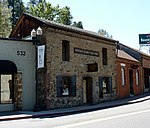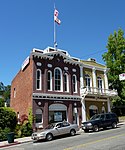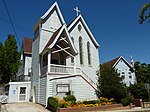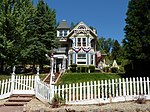Placerville, California
1854 establishments in CaliforniaCalifornia Gold RushCalifornia Historical LandmarksCities in El Dorado County, CaliforniaCities in Sacramento metropolitan area ... and 9 more
County seats in CaliforniaIncorporated cities and towns in CaliforniaMining communities of the California Gold RushPlacerville, CaliforniaPony Express stationsPopulated places established in 1848Populated places established in 1854U.S. Route 50Use mdy dates from September 2014

Placerville (, PLASS-ər-vil; formerly Old Dry Diggings, Dry Diggings, and Hangtown) is a city in and the county seat of El Dorado County, California. The population was 10,747 as of the 2020 census, up from 10,389 as of the 2010 census. It is part of the Sacramento–Arden-Arcade–Roseville Metropolitan Statistical Area.
Excerpt from the Wikipedia article Placerville, California (License: CC BY-SA 3.0, Authors, Images).Placerville, California
Main Street,
Geographical coordinates (GPS) Address Nearby Places Show on map
Geographical coordinates (GPS)
| Latitude | Longitude |
|---|---|
| N 38.729722222222 ° | E -120.79861111111 ° |
Address
Fountain and Tallman Soda Factory Museum
Main Street
95667
California, United States
Open on Google Maps








